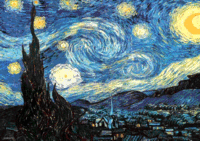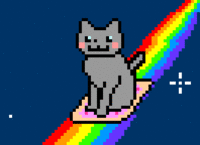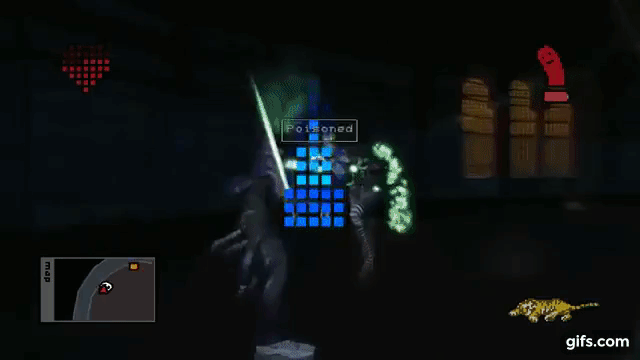GIF

About
The Graphics Interchange Format (always shortened as GIF) is a bitmap image format widely used on the Internet for its flexible web support and portability. The format, which supports up to 8 bits per pixel and a palette of up to 256 distinct colors for each frame, is well-suited for handling simpler images like graphics and logos with solid color areas, while it doesn't fare as well in reproduction of color photographs with continuous colors. GIF was one of the first two image formats commonly used on the web and the first image format to support color display until the arrival of JPEG in 1992.[1]
Online History
GIF format was introduced by the first major U.S. commercial online service Compuserve in 1987 to provide a more robust format for the purpose of uploading and downloading color images, which replaced its earlier run-length encoding (RLE) format in black and white only. The original version of the GIF format was labeled "87a" and released on June 15th, 1987, soon followed by the 1989 release of its enhanced successor "89a," which featured support for animation delays, transparent background colors and storage of application-specific metadata. The very first GIF depicting an airplane was presented by CompuServe in 1987, according to the inventor Steve Wilhite's interview with The Daily Dot[10] in 2012.
Browser Compatibility
In 1991, Tim Berners Lee opened the web to the public with the launch of the World Wide Web project. Soon after that in January 1993, one of the first popular web browsers Mosaic (shown below, left) was unveiled with capability to embed images into an HTML page. Mosaic browser then evolved into the foundation for Netscape Navigator (shown below, right), which was released in December 1994. The 2.0 version of Netscape Navigator is widely credited with pioneering the technology of Application Extension Blocks, enabling the automatic looping of animated GIFs displayed in webpages. This feature was soon adapted by other browsers in the following years, thus paving the road for the ubiquity of animated GIFs in the years to come.


30th Anniversary
On June 15th, 2017, Twitter user Doug KcKenzie posted what is believed to be the first animated GIF in honor of the format's 30th birthday (shown below). Within 24 hours, the tweet gathered upwards of 2,600 likes and 1,600 retweets. That day, Twitter created a Moments[11] page for the 30th anniversary of the GIF, highlighting notables jokes, GIFs and factoids about the format.
The GIF is 30 years old today. Here is the first ever gif (pronounced (jif) #gif #firstgif #happybirthdaygif pic.twitter.com/MxxbuFO34A
— Doug McKenzie (@dougmckenzie) June 15, 2017
Meanwhile, Facebook added several GIF-related features to the social networking platform, allowing users to include GIFs in comments and search through relevant animated images through the Facebook user interface.[12]

Reception
Being one of the first universally supported image formats with color display and looped animation features, the presence of GIF skyrocketed in the early 1990s as Internet users began experimenting with the image format for decorating their personal webpages. However, the use of GIF for still images began to diminish with the subsequent arrival of Joint Photographic Experts Group (JPEG) and Portable Network Graphics (PNG) formats.
Early Internet Usage
Web administrators began using GIF files mainly for its support of color display in 256 colors. One of the first notable projects to utilize this format was GIF News, an online newsletter that was distributed every 60 days or so through BBSes between 1988 and 1993.

Following the launch of personal web hosting services and basic HTML-editing platforms like Geocities and Tripod in 1995, use of GIF files in website design became nearly ubiquitous and even over-saturated. Animated GIF banners with specific functions also became popular, the most notable examples being dancing flames, flashing "new" signs and waving American flags for decorations, constantly opening-and-closing mailboxes for linking to e-mail address and contact pages, as well "under construction" roadsigns used to notify visitors that the webpage is unavailable at the moment.




GIF Oversaturation
Meanwhile, the indiscriminate usage of animated GIFs eventually led to its negative associations with tacky web design and poor sense of aesthetics, not to mention the constant reloading of bright, high contrast-colored animations posed distraction for the readers. Some Internet users became so annoyed by the overwhelming presence of GIFs on webpages that they coined the phenomenon "banner blindness."

By the late 1990s, GIF format began to lose its glow of fashionable connotation with the growing criticisms against its inefficiency for displaying still images and indiscriminate usage that led to "banner blindness," not to mention that advertisers began to prefer text-based or flash-based banners over flashy, distractive animations. Furthermore, the arrival of newer and more efficient compression technologies like Adobe Flash, JPEG and PNG image formats also contributed to the diminishing influence of GIFs.

Pre-YouTube Era
While GIF was no longer considered the staple image format in web design at the dawn of the new century, its unique auto-play and auto-loop features gave rise to another widespread use, this time, in the rapidly growing world of Internet culture. In fact, some of the earliest known Internet memes and viral media took the form of GIF animations, such as the Dancing Baby and the Hampster Dance and Bunchie.



Several years later, GIF format demonstrated its potential use in web entertainment and Internet humor in 2001 when Max Goldberg launched a single serving site called "You're the Man Now, Dog," which eventually became known as YTMND, an online community centered on the creation of web pages featuring a still image or short GIF animation along with large caption text and a looping audio file. At the peak of its popularity between 2004 to 2007, the website became considered a major hubsite of Internet memes. However, the growth of GIF-based YTMND sites began to wane circa 2008 with the arrival of instant video-streaming sites like YouTube.

Resurgence in Web 2.0
Despite the advents of high quality video-streaming services and video-sharing communities in the late 2000s and early 2010s, GIFs didn't fade away into oblivion. Instead, the seemingly outdated image format became embraced by many users on photo-sharing platforms and social networking sites like Tumblr, Imgur and Google Plus that supported GIF animation, giving rise to its second renaissance.
Impact
The reinvigorated online interest in GIFs may be also attributed to the availability of generator applications that require little efforts and skills to create one, compounded by massive increase in volume of online videos in circulation, which in turn serves as the repository for GIF-makers.
YTMND
For more information, head over to KYMdb – YTMND.



In Photography



In Pixel Art
For more information, head over to KYMdb – Pixel Art.



In Reaction Images
For more information, head over to KYMdb – Reaction Images.






Search Interest
External References
[1] Wikipedia – Graphics Interchange Format
[2] BoingBoing (via Wayback Machine) – The History of GIF News
[3] YouTube – Animated GIFs / The Birth of a Medium#!
[4] Daily Dot – 25 Year Anniversary GIF collections
[5] The Verge – The GIF was unleashed on the world 25 years ago today
[6] Gizmodo – Happy Birthday to the GIF / The Internet’s Greatest Treasure Turns 25
[8] Enthusiasm – GIF, A Technical History
[9] Complex – A History of the 50 Greatest Animated GIFs of All Time
[10] Daily Dot – The animated history of the GIF
[11] Twitter – The GIF turns 30
[12] Facebook – Celebrating 30 Years of the GIF




















